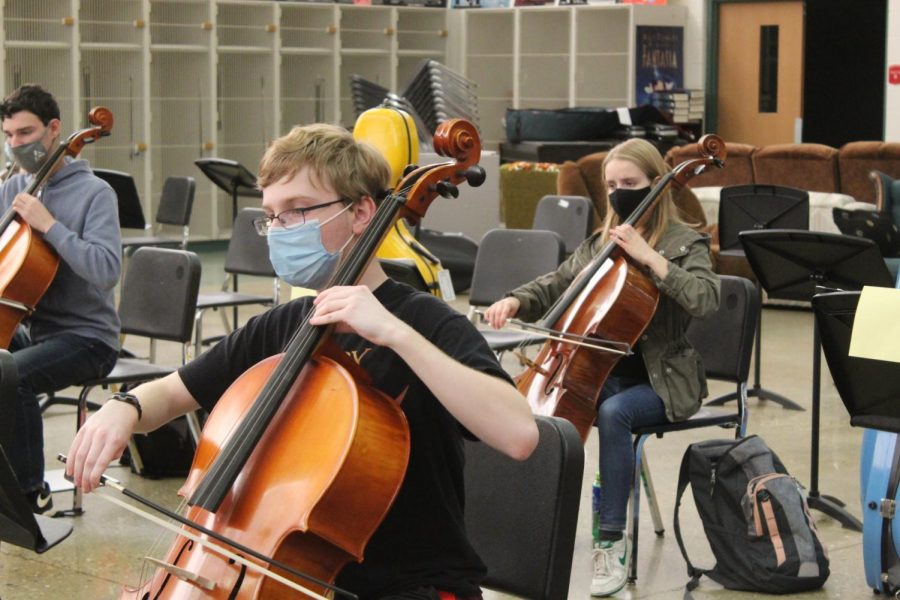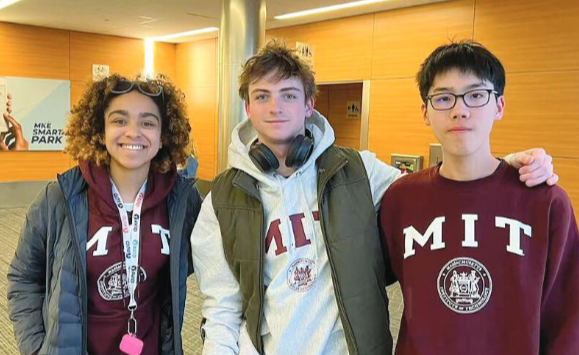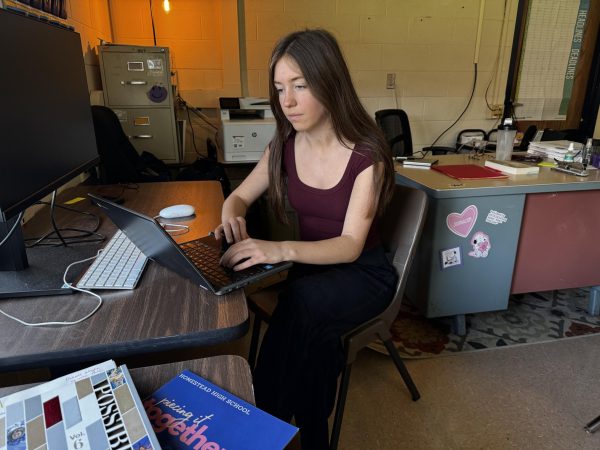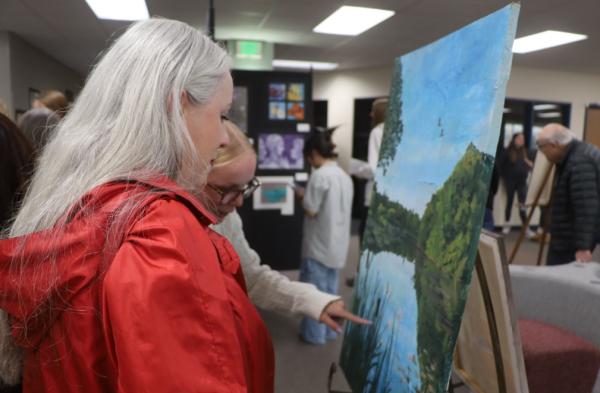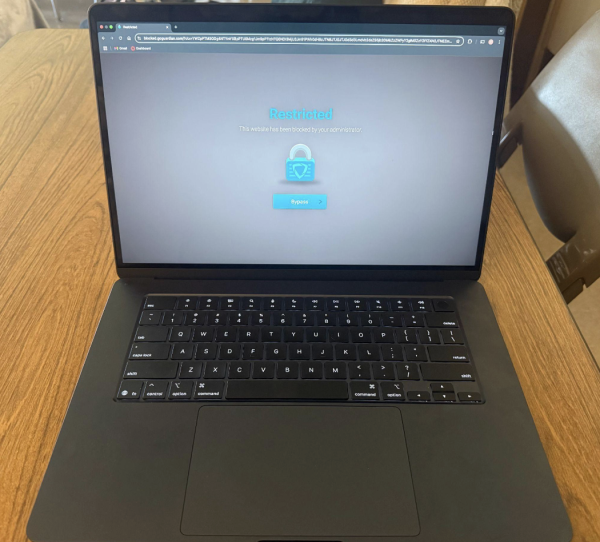Being a music student during COVID
How the Homestead music department is adjusting to changes
Orchestra students practice their instruments during class.
Walking through the music wing this year, it is easy to notice that things look different. Just as COVID-19 has changed daily life, it has changed the way musicians function.
Schools across the nation are all navigating this unprecedented situation differently. The approaches vary depending upon what works best for each school’s scenario. However, one thing is clear: it is not easy.
Due to the nature of the virus, playing wind instruments or singing can be dangerous if not done correctly. The majority of coronavirus infections are caused by lingering droplets in the air, the reason why maintaining a distance of at least six feet from others is crucial. Special PPE for musicians is necessary for those playing wind instruments in ensembles during the pandemic.
The PPE differs depending on the instrument, but the general principles remain the same. Most masks have a slit for musicians to insert their mouthpieces and are used in conjunction with a bell cover or bag for the end of their instrument, where the majority of air escapes.
At Homestead this trimester, both Concert Band and Symphony Band are rehearsing indoors. All musicians are required to use their appropriate PPE and, rather than the traditional arched seating arrangement, the bands are set up in straight rows, with six foot distance from any given side of their seats.
Anna Nguyen, senior, appreciates that the wind instrument PPE allows the band to continue performing after marching season. “PPE is weird to get used to, but we can play inside instead of outside,” Nguyen said.
In addition to needing to use PPE, the band can only rehearse in 30 minute intervals so that any lingering particles have time to clear from the air.
This limited rehearsal time has forced Todd Spindler, band director, to think outside of the box for lesson plans. “Our goal in band this year is to continue pursuing our normal curriculum to the best of our ability. We are putting more of a focus on individual skills and music theory comprehension as we work together, though,” Spindler said.
Despite the setbacks of performing during the pandemic and unbalanced instrumentation, Spindler is preparing the bands for an outdoor Benefit Concert in May. Virtual concerts are being considered in addition to this concert; however, Spindler hopes the Benefit Concert can serve as a way to celebrate the musicians’ effort and tenacity.
As a part of the daily routine, distance learners attend band via Zoom. This allows them the opportunity to play along, while their audio is muted, and participate in daily activities.
Katie Quasius, senior, is attending band digitally. “Being in virtual band is definitely very different from being in person. Not only is the sound of the instruments different, but it’s also harder to see the conductor and my music at the same time; I do think, though, that it’s good to be online because instruments make air travel faster, which may spread COVID more,” Quasius said.
Though some prefer to remain at home, all virtual music students have the option to return to campus solely for band, choir or orchestra.
Isabelle Kramar, senior, took advantage of this opportunity, and heads back to Homestead for the class periods when she has orchestra. “I am virtual for every other class, but I am grateful for the fact that I can come in-person just for orchestra. I’m very thankful that I have a safe environment to play the cello and that I can still have something to enjoy and look forward to during my senior year amidst these scary times,” Kramar said.
Unlike in band, projection of droplets is not an issue at the forefront in orchestra since string instruments are not played through a mouthpiece and, therefore, do not require special PPE. However, the students are spaced out with six feet on any side of their chair and are not sharing stands in order to be in accordance with CDC guidelines.
On Dec. 8 through Dec. 10, orchestra students took part in concert recording sessions. Each of the four ensembles recorded their parts during their respective class periods, which will be professionally edited into a video and shared with the community. Distance learners recorded themselves performing from home, following along over Zoom; their videos will be combined into the final product as well.
John Emanuelson, orchestra director, is thankful that the ensembles could put on a performance, regardless of how different the format is from past years. Not only are orchestra concerts different, but also the curriculum has changed this year.
Due to the length of the class periods, Emanuelson decided to add variety through a history unit. “I have added a new strand of teaching about the history of orchestra, starting with JS Bach and the Baroque era. I have always wanted to teach my students this information, so this is a great year to do this, as a way of breaking up our three and a half or two and a half hour classes,” Emanuelson said.
Virtual orchestra students participate in class over Zoom, with their cameras on and their microphones muted.
Leila Mohsenian, senior, has found this to be a challenging yet valuable experience. “It’s hard, because I can’t hear the rest of my section distinctly, like I normally would when sitting with them, but there are many skills that Mr. E has taught us in previous years that I think really made it possible, such as listening to professional recordings of the pieces we are playing, sight reading, and practice habits. Being online also allows me to see myself on the screen, so I can watch my posture in a way I never have before, and I find that really fascinating,” Mohsenian said.
In choir, projection of droplets is much more of a concern than in orchestra. Therefore, in addition to following CDC guidelines for social distancing and mask wearing, the choirs participate in a half an hour of activities other than singing after each half hour of rehearsing.
Audrey Ferrero, senior, believes that these difficulties are rewarding to overcome. “Although choir depends on listening to ensemble members to remain in pitch and build harmonies, which often requires closer distance, I think we have grown as musicians and are overcoming the obstacles of rehearsing in masks and staying a further distance away from each other,” Ferrero said.
Virtual students participate in choir over Zoom and utilize breakout rooms to learn their individual parts accompanied by the piano. Additionally, they submit sight reading videos over Canvas.
Distance learner Morgan Limbach, senior, is somewhat optimistic about this format. “Difficulties with music online is that we can never hear the sound of a big ensemble or be a part of it physically. But the good thing is that, if we practice on our own, when we come together we can make amazing virtual performances and still create great music together,” Limbach said.
The choirs are planning on performing a virtual concert this year, to be put together by choir director Cortney Hammer.
Band, orchestra and choir have faced many challenges this year; however, the groups have been resilient and have tried to face the obstacles to the best of their abilities. Regardless, both music students and teachers made it clear that they are eager for the day when rehearsing and performing has returned to normal.
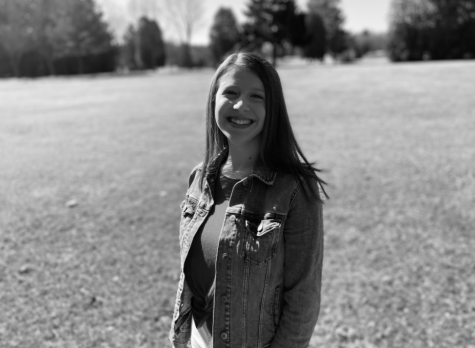
Ainsley Feigles is a senior at Homestead High School. She has always had a passion for writing and is enjoying spending her second year with Highlander...
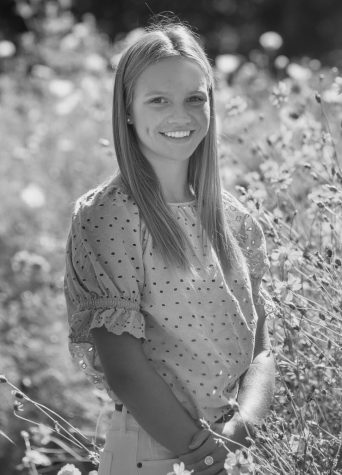
Rachel Starsky is a senior at Homestead High School. In room 405, she is often found designing yearbook or writing sports articles. In her free time, she...

